哈夫曼树
哈夫曼树的数据结构很简单,每一次都将权值最小的两个的节点合成一个更大的节点,然后放到优先级队列里面,如此操作之后,所有的节点都在叶子节点。
#pragma once
#include <iostream>
#include <queue>
#include <vector>
using namespace std;
template <class W>
struct HuffmanTreeNode
{
HuffmanTreeNode(const W &weight)
: _pLeft(NULL), _pRight(NULL), _pParent(NULL), _weight(weight)
{
}
HuffmanTreeNode<W> *_pLeft;
HuffmanTreeNode<W> *_pRight;
HuffmanTreeNode<W> *_pParent;
W _weight;
};
template <class W>
class HuffmanTree
{
typedef HuffmanTreeNode<W> *PNode;
private:
PNode _pRoot;
public:
HuffmanTree()
: _pRoot(NULL)
{
}
HuffmanTree(W *array, size_t size)
{
_CreateHuffmantree(array, size);
}
void _Destroy(PNode &pRoot)
{
//后序
if (pRoot)
{
_Destroy(pRoot->_pLeft);
_Destroy(pRoot->_pRight);
delete pRoot;
pRoot = NULL;
}
}
~HuffmanTree()
{
_Destroy(_pRoot);
}
PNode GetRoot()
{
return _pRoot;
}
private:
//构建哈夫曼树
void _CreateHuffmantree(W *array, size_t size)
{
struct PtrNodeCompare
{
bool operator()(PNode n1, PNode n2) //重载“()”
{
return n1->_weight < n2->_weight;
}
};
priority_queue<PNode, vector<PNode>, PtrNodeCompare> hp; //
for (size_t i = 0; i < size; ++i)
{
hp.push(new HuffmanTreeNode<W>(array[i])); // 数据入堆
}
//空堆
if (hp.empty())
_pRoot = NULL;
while (hp.size() > 1) // 取两个出来只回收1个
{
PNode pLeft = hp.top();
hp.pop();
PNode pRight = hp.top();
hp.pop();
PNode pParent = new HuffmanTreeNode<W>(pLeft->_weight + pRight->_weight); //左加右的权值,作为新节点
pParent->_pLeft = pLeft;
pLeft->_pParent = pParent;
pParent->_pRight = pRight;
pRight->_pParent = pParent;
hp.push(pParent);
}
_pRoot = hp.top(); // 根节点在堆顶
}
};
用哈夫曼树压缩文件
根据哈夫曼树的特性,我们首先需要统计文件中所有字符(char)的出现次数,生成对应的“码表”(字符+次数),然后码表构建哈夫曼树。码表是我们用来压缩和解压缩的重要数据结构。
以下是对应的字符结构体:
struct CharInfo
{
unsigned char _ch; //字符 比如字符a
unsigned int _count; //字符次数 比如字符a出现45
string _code; //对应的哈夫曼编码 字符a构建的哈夫曼编码为011100
bool operator!=(const CharInfo &info)
{
return _count != info._count;
}
CharInfo operator+(const CharInfo &info)
{
CharInfo ret;
ret._count = _count + info._count;
return ret;
}
bool operator>(const CharInfo &info)
{
return _count > info._count;
}
};
在文件压缩和解压缩的类型中,有以下成员变量和函数:
//获取文件的大小
unsigned long getFileSize(const char *path)
{
unsigned long filesize = -1;
FILE *fp;
fp = fopen(path, "r");
if (fp == NULL)
{
return filesize;
}
fseek(fp, 0L, SEEK_END);
filesize = ftell(fp);
fclose(fp);
return filesize;
}
struct CharInfo
{
unsigned char _ch; //字符 a
unsigned int _count; //字符次数 45
string _code; //对应的哈夫曼编码 011100
bool operator!=(const CharInfo &info)
{
return _count != info._count;
}
CharInfo operator+(const CharInfo &info)
{
CharInfo ret;
ret._count = _count + info._count;
return ret;
}
bool operator>(const CharInfo &info)
{
return _count > info._count;
}
};
class FileCompressAndUnCompress
{
typedef HuffmanTreeNode<CharInfo> Node;
struct TmpInfo
{
unsigned char _ch; //字符
unsigned int _count; //次数
};
protected:
CharInfo _infos[256];
public:
//构造函数
FileCompressAndUnCompress()
{
for (size_t i = 0; i < 256; ++i)
{
_infos[i]._ch = i;
_infos[i]._count = 0;
}
}
//获取哈夫曼编码
void GenerateHuffmanCode(Node *root, string code)
{
if (root == NULL)
return;
//前序遍历生成编码
if (root->_pLeft == NULL && root->_pRight == NULL)
{
_infos[(unsigned char)root->_weight._ch]._code = code; // 码值
return;
}
GenerateHuffmanCode(root->_pLeft, code + '0');
GenerateHuffmanCode(root->_pRight, code + '1');
}
void Compress(const char *file);
void Uncompress(const char *file);
};
压缩
void Compress(const char *file) // file:要压缩的文件
{
//获取文件的大小
unsigned long fileSize = getFileSize(file);
// 1.统计字符出现的次数
FILE *fout = fopen(file, "rb");
assert(fout);
char ch = fgetc(fout);
while (feof(fout) == 0) //文件结束,则返回值为1,否则为0
{
_infos[(unsigned char)ch]._count++; // 计算对应字符出现的频率
ch = fgetc(fout);
}
// 2.生成Huffmantree 及code
// 2.1 生成Huffmantree, 构建哈夫曼树
HuffmanTree<CharInfo> tree(_infos, 256);
string compressfile = file;
compressfile += ".huffman";
FILE *fin = fopen(compressfile.c_str(), "wb"); //打开压缩文件
assert(fin);
string code;
// 2.2 根据哈夫曼树每个字符对应的code
GenerateHuffmanCode(tree.GetRoot(), code);
// 2.3 将码表写入压缩文件中
int writeNum = 0;
int objSize = sizeof(TmpInfo);
for (size_t i = 0; i < 256; ++i)
{
if (_infos[i]._count > 0)
{
TmpInfo info;
info._ch = _infos[i]._ch;
info._count = _infos[i]._count;
printf("codec ch:%u, cout:%u\n", (unsigned char)info._ch, info._count);
fwrite(&info, objSize, 1, fin);
writeNum++;
}
}
//把info._count = -1写进去作为数据字典的结束标志位
TmpInfo info;
info._count = -1;
printf("code objSize:%d\n", objSize);
fwrite(&info, objSize, 1, fin);
// 3.开始压缩文件
int writeCount = 0;
int readCount = 0;
//文件指针回到开头
fseek(fout, 0, SEEK_SET); //文件指针、偏移量、参照位置
ch = fgetc(fout);
readCount++;
unsigned char value = 0;
size_t pos = 0;
while (feof(fout) == 0) // 一个个字符读取
{
// 读取数据,查找对应编码
string &code = _infos[(unsigned char)ch]._code; // 查找对应的编码
printf("code[%d]:%u:%s\n", readCount, (unsigned char)ch, code.c_str());
// 根据对应的编码,修改对应的value值
for (size_t i = 0; i < code.size(); ++i)
{
if (code[i] == '1')
{
value |= (1 << pos);
}
else if (code[i] != '0')
{
assert(false);
printf("assert(false); ??????????");
}
++pos;
if (pos == 8)
{
writeCount++;
// 够8个bit就存储一次,不用担心code是否全部读完
fputc(value, fin);
value = 0;
pos = 0;
}
}
readCount++;
ch = fgetc(fout);
}
//最后可能不够8bit,也存储进去
if (pos > 0)
{
writeCount++;
fputc(value, fin); //写入压缩文件(fin)
}
printf("码表的大小:%d字节\n", objSize * (writeNum + 1));
printf("压缩后的文件大小:%d字节\n", writeCount);
unsigned long totalSize = writeCount + objSize * (writeNum + 1);
printf("压缩后总文件大小:%lu字节, 原始文件大小:%lu字节, 压缩率:%0.2f\n",
totalSize, fileSize, (float)(totalSize * 1.0 / fileSize));
fclose(fout);
fclose(fin);
}
以下面的测试文件为例:
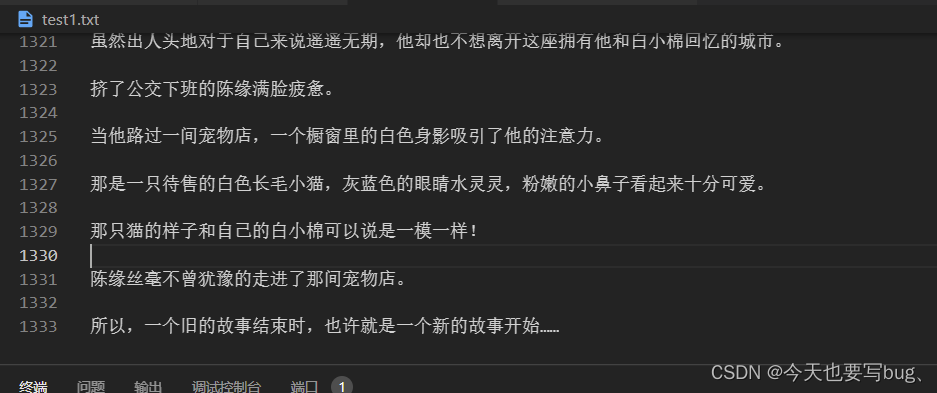
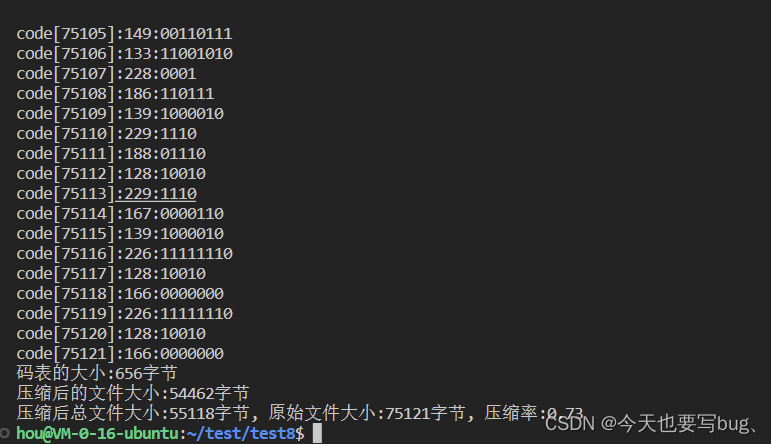
如果压缩文件中相同字符的重复率很高,那压缩效率会大幅提高:
以全部为1的文件为例:
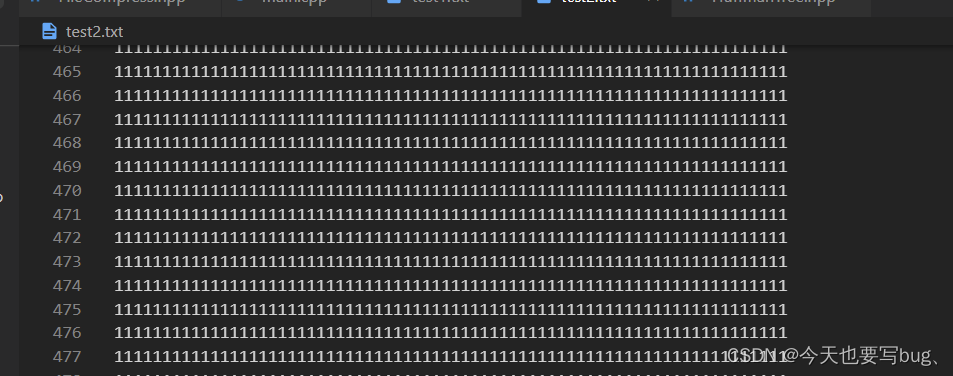
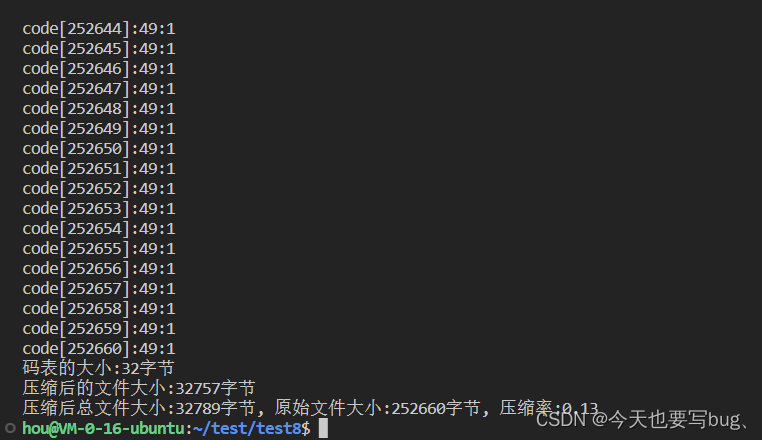
解压缩
void Uncompress(const char *file) //要解压缩的文件
{
string uncompressfile = file;
//找到最后一个'.'
size_t pos = uncompressfile.rfind('.');
assert(pos != string::npos);
//删除掉".huffman"后缀
uncompressfile.erase(pos);
// uncompressfile += ".unhuffman";
FILE *fin = fopen(uncompressfile.c_str(), "wb"); //打开解压缩文件
assert(fin);
FILE *fout = fopen(file, "rb"); //打开压缩文件
assert(fout);
// 读入码表
TmpInfo info;
int cycleNum = 1;
int objSize = sizeof(TmpInfo);
fread(&info, objSize, 1, fout);
while (info._count != -1) //-1为结束标志
{
_infos[(unsigned char)info._ch]._ch = info._ch;
_infos[(unsigned char)info._ch]._count = info._count;
fread(&info, objSize, 1, fout);
cycleNum++;
}
//根据码表重建huaffman树
HuffmanTree<CharInfo> tree(_infos, 256); //参数:数组,256个,无效值(出现0次)
Node *root = tree.GetRoot();
Node *cur = root;
unsigned int n = root->_weight._count; //所有叶子节点的和(源文件字符的个数)
char ch = fgetc(fout); //从fout(压缩文件)读字符
int readCount = 0;
while (ch != EOF || n > 0)
{
for (size_t i = 0; i < 8; ++i)
{
if ((ch & (1 << i)) == 0)
cur = cur->_pLeft; // 往左边找
else
cur = cur->_pRight; // 往右边找
if (cur->_pLeft == NULL && cur->_pRight == NULL)
{
// cout << cur->_weight._ch;
//找到对应的字符,写入解压缩文件
fputc(cur->_weight._ch, fin);
cur = root;
if (--n == 0)
break;
}
}
ch = fgetc(fout);
}
printf("解压缩完成\n");
fclose(fin);
fclose(fout);
}
对上面的压缩文件进行解压缩:
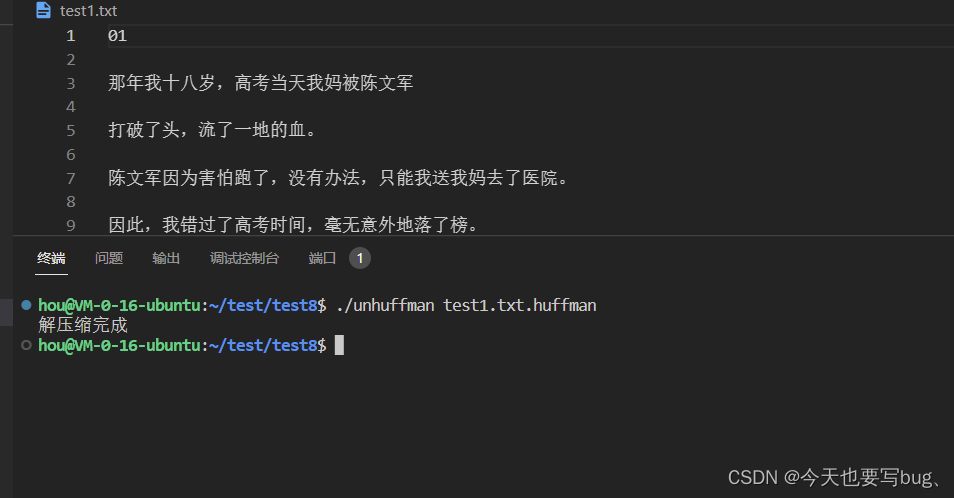
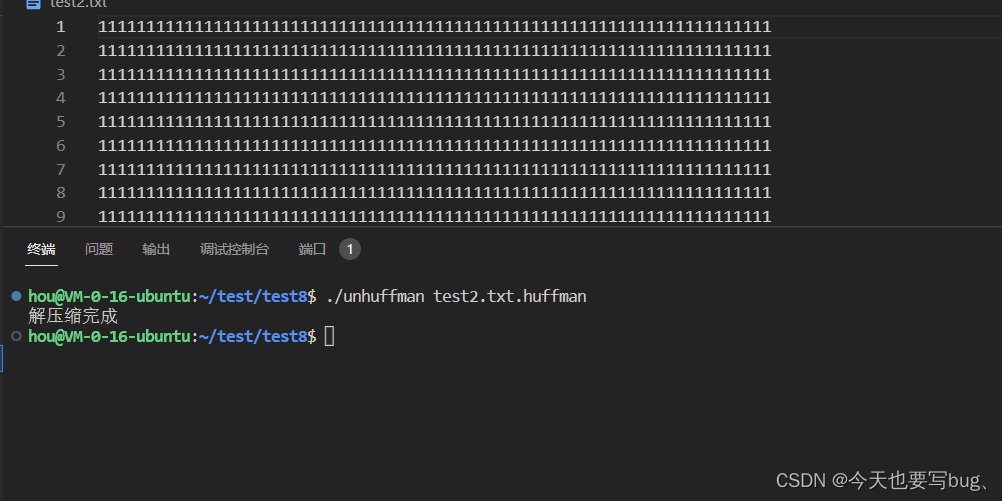
全部代码
- HuffmanTree.hpp:
#pragma once
#include <iostream>
#include <queue>
#include <vector>
using namespace std;
template <class W>
struct HuffmanTreeNode
{
HuffmanTreeNode(const W &weight)
: _pLeft(NULL), _pRight(NULL), _pParent(NULL), _weight(weight)
{
}
HuffmanTreeNode<W> *_pLeft;
HuffmanTreeNode<W> *_pRight;
HuffmanTreeNode<W> *_pParent;
//权值
W _weight;
};
template <class W>
class HuffmanTree
{
typedef HuffmanTreeNode<W> *PNode;
private:
//根节点
PNode _pRoot;
public:
HuffmanTree()
: _pRoot(NULL)
{
}
HuffmanTree(W *array, size_t size)
{
_CreateHuffmantree(array, size);
}
void _Destroy(PNode &pRoot)
{
//后序
if (pRoot)
{
_Destroy(pRoot->_pLeft);
_Destroy(pRoot->_pRight);
delete pRoot;
pRoot = NULL;
}
}
~HuffmanTree()
{
_Destroy(_pRoot);
}
PNode GetRoot()
{
return _pRoot;
}
private:
//构建哈夫曼树
void _CreateHuffmantree(W *array, size_t size)
{
//小根堆
struct PtrNodeCompare
{
bool operator()(PNode n1, PNode n2) //重载“()”
{
return n1->_weight > n2->_weight;
}
};
priority_queue<PNode, vector<PNode>, PtrNodeCompare> hp;
for (size_t i = 0; i < size; ++i)
{
hp.push(new HuffmanTreeNode<W>(array[i])); // 数据入堆
}
//空堆
if (hp.empty())
{
_pRoot = NULL;
}
while (hp.size() > 1) // 取两个出来只回收1个
{
PNode pLeft = hp.top();
hp.pop();
PNode pRight = hp.top();
hp.pop();
PNode pParent = new HuffmanTreeNode<W>(pLeft->_weight + pRight->_weight); //左加右的权值,作为新节点
pParent->_pLeft = pLeft;
pLeft->_pParent = pParent;
pParent->_pRight = pRight;
pRight->_pParent = pParent;
hp.push(pParent);
}
_pRoot = hp.top(); // 根节点在堆顶
}
};
- FileCompress.hpp(压缩和解压缩的头文件)
/*利用库中的优先级队列实现哈夫曼树,最后基于哈夫曼树最终实现文件压缩。
描述:
1.统计文件中字符出现的次数,利用优先级队列构建Haffman树,生成Huffman编码。
构造过程可以使用priority_queue辅助,每次pq.top()都可以取出权值(频数)最小的节点。每取出两个最小权值的节点,就new出一个新的节点,左右孩子分别指向它们。然后把这个新节点push进优先队列。
2.压缩:利用Haffman编码对文件进行压缩,即在压缩文件中按顺序存入每个字符的Haffman编码。
3.将文件中出现的字符以及它们出现的次数写入配置文件中,以便后续压缩使用。
4.解压缩:利用配置文件重构Haffman树,对文件进行减压缩。
*/
#pragma once
#include "HuffmanTree.hpp"
#include <iostream>
#include <vector>
#include <assert.h>
using namespace std;
//获取文件的大小
unsigned long getFileSize(const char *path)
{
unsigned long filesize = -1;
FILE *fp;
fp = fopen(path, "r");
if (fp == NULL)
{
return filesize;
}
fseek(fp, 0L, SEEK_END);
filesize = ftell(fp);
fclose(fp);
return filesize;
}
struct CharInfo
{
unsigned char _ch; //字符 a
unsigned int _count; //字符次数 45
string _code; //对应的哈夫曼编码 011100
bool operator!=(const CharInfo &info)
{
return _count != info._count;
}
CharInfo operator+(const CharInfo &info)
{
CharInfo ret;
ret._count = _count + info._count;
return ret;
}
bool operator>(const CharInfo &info)
{
return _count > info._count;
}
};
class FileCompressAndUnCompress
{
typedef HuffmanTreeNode<CharInfo> Node;
struct TmpInfo
{
unsigned char _ch; //字符
unsigned int _count; //次数
};
protected:
CharInfo _infos[256];
public:
//构造函数
FileCompressAndUnCompress()
{
for (size_t i = 0; i < 256; ++i)
{
_infos[i]._ch = i;
_infos[i]._count = 0;
}
}
//获取哈夫曼编码
void GenerateHuffmanCode(Node *root, string code)
{
if (root == NULL)
return;
//前序遍历生成编码
if (root->_pLeft == NULL && root->_pRight == NULL)
{
_infos[(unsigned char)root->_weight._ch]._code = code; // 码值
return;
}
GenerateHuffmanCode(root->_pLeft, code + '0');
GenerateHuffmanCode(root->_pRight, code + '1');
}
void Compress(const char *file) // file:要压缩的文件
{
//获取文件的大小
unsigned long fileSize = getFileSize(file);
// 1.统计字符出现的次数
FILE *fout = fopen(file, "rb");
assert(fout);
char ch = fgetc(fout);
while (feof(fout) == 0) //文件结束,则返回值为1,否则为0
{
_infos[(unsigned char)ch]._count++; // 计算对应字符出现的频率
ch = fgetc(fout);
}
// 2.生成Huffmantree 及code
// 2.1 生成Huffmantree, 构建哈夫曼树
HuffmanTree<CharInfo> tree(_infos, 256);
string compressfile = file;
compressfile += ".huffman";
FILE *fin = fopen(compressfile.c_str(), "wb"); //打开压缩文件
assert(fin);
string code;
// 2.2 根据哈夫曼树每个字符对应的code
GenerateHuffmanCode(tree.GetRoot(), code);
// 2.3 将码表写入压缩文件中
int writeNum = 0;
int objSize = sizeof(TmpInfo);
for (size_t i = 0; i < 256; ++i)
{
if (_infos[i]._count > 0)
{
TmpInfo info;
info._ch = _infos[i]._ch;
info._count = _infos[i]._count;
printf("codec ch:%u, cout:%u\n", (unsigned char)info._ch, info._count);
fwrite(&info, objSize, 1, fin);
writeNum++;
}
}
//把info._count = -1写进去作为数据字典的结束标志位
TmpInfo info;
info._count = -1;
printf("code objSize:%d\n", objSize);
fwrite(&info, objSize, 1, fin);
// 3.开始压缩文件
int writeCount = 0;
int readCount = 0;
//文件指针回到开头
fseek(fout, 0, SEEK_SET); //文件指针、偏移量、参照位置
ch = fgetc(fout);
readCount++;
unsigned char value = 0;
size_t pos = 0;
while (feof(fout) == 0) // 一个个字符读取
{
// 读取数据,查找对应编码
string &code = _infos[(unsigned char)ch]._code; // 查找对应的编码
printf("code[%d]:%u:%s\n", readCount, (unsigned char)ch, code.c_str());
// 根据对应的编码,修改对应的value值
for (size_t i = 0; i < code.size(); ++i)
{
if (code[i] == '1')
{
value |= (1 << pos);
}
else if (code[i] != '0')
{
assert(false);
printf("assert(false); ??????????");
}
++pos;
if (pos == 8)
{
writeCount++;
// 够8个bit就存储一次,不用担心code是否全部读完
fputc(value, fin);
value = 0;
pos = 0;
}
}
readCount++;
ch = fgetc(fout);
}
//最后可能不够8bit,也存储进去
if (pos > 0)
{
writeCount++;
fputc(value, fin); //写入压缩文件(fin)
}
printf("码表的大小:%d字节\n", objSize * (writeNum + 1));
printf("压缩后的文件大小:%d字节\n", writeCount);
unsigned long totalSize = writeCount + objSize * (writeNum + 1);
printf("压缩后总文件大小:%lu字节, 原始文件大小:%lu字节, 压缩率:%0.2f\n",
totalSize, fileSize, (float)(totalSize * 1.0 / fileSize));
fclose(fout);
fclose(fin);
}
void Uncompress(const char *file) //要解压缩的文件
{
string uncompressfile = file;
//找到最后一个'.'
size_t pos = uncompressfile.rfind('.');
assert(pos != string::npos);
//删除掉".huffman"后缀
uncompressfile.erase(pos);
// uncompressfile += ".unhuffman";
FILE *fin = fopen(uncompressfile.c_str(), "wb"); //打开解压缩文件
assert(fin);
FILE *fout = fopen(file, "rb"); //打开压缩文件
assert(fout);
// 读入码表
TmpInfo info;
int cycleNum = 1;
int objSize = sizeof(TmpInfo);
fread(&info, objSize, 1, fout);
while (info._count != -1) //-1为结束标志
{
_infos[(unsigned char)info._ch]._ch = info._ch;
_infos[(unsigned char)info._ch]._count = info._count;
fread(&info, objSize, 1, fout);
cycleNum++;
}
//根据码表重建huaffman树
HuffmanTree<CharInfo> tree(_infos, 256); //参数:数组,256个,无效值(出现0次)
Node *root = tree.GetRoot();
Node *cur = root;
unsigned int n = root->_weight._count; //所有叶子节点的和(源文件字符的个数)
char ch = fgetc(fout); //从fout(压缩文件)读字符
int readCount = 0;
while (ch != EOF || n > 0)
{
for (size_t i = 0; i < 8; ++i)
{
if ((ch & (1 << i)) == 0)
cur = cur->_pLeft; // 往左边找
else
cur = cur->_pRight; // 往右边找
if (cur->_pLeft == NULL && cur->_pRight == NULL)
{
// cout << cur->_weight._ch;
//找到对应的字符,写入解压缩文件
fputc(cur->_weight._ch, fin);
cur = root;
if (--n == 0)
break;
}
}
ch = fgetc(fout);
}
printf("解压缩完成\n");
fclose(fin);
fclose(fout);
}
};
- compress.cpp(压缩文件)
#include "FileCompress.hpp"
#include <iostream>
#include <vector>
#include <assert.h>
int main(int argc, char **argv)
{
if (argc != 2)
{
std::cout << "usage: " << argv[0] << ": <input_file> " << std::endl;
return 1;
}
FileCompressAndUnCompress fc;
std::string fileName(argv[1]);
fc.Compress(fileName.c_str()); // 压缩文件
return 0;
}
- uncompress.cpp(解压缩文件)
#include "FileCompress.hpp"
#include <iostream>
#include <vector>
#include <assert.h>
int main(int argc, char **argv)
{
if (argc != 2)
{
std::cout << "usage: " << argv[0] << ": <input_file> " << std::endl;
return 1;
}
FileCompressAndUnCompress fc;
std::string fileName(argv[1]);
fc.Uncompress(fileName.c_str()); // 解压缩文件
return 0;
}























 8558
8558











 被折叠的 条评论
为什么被折叠?
被折叠的 条评论
为什么被折叠?










